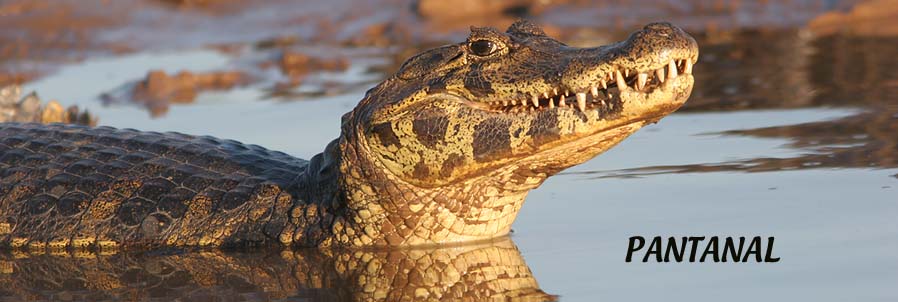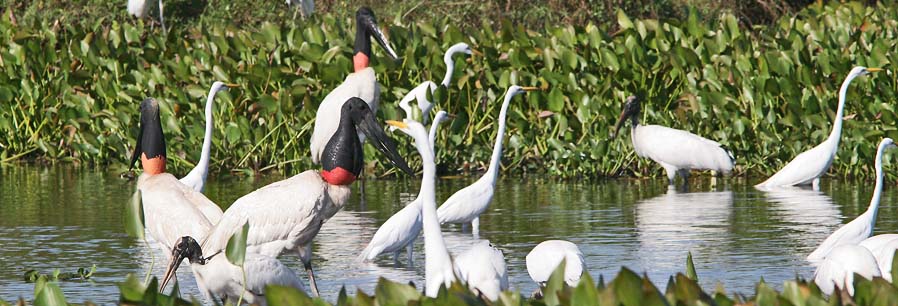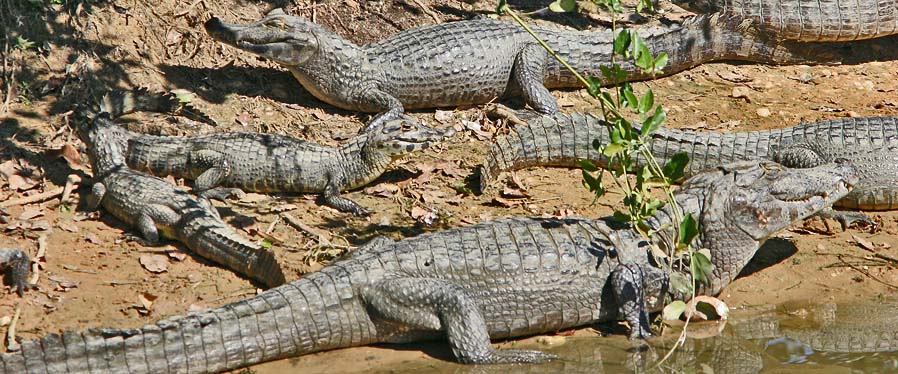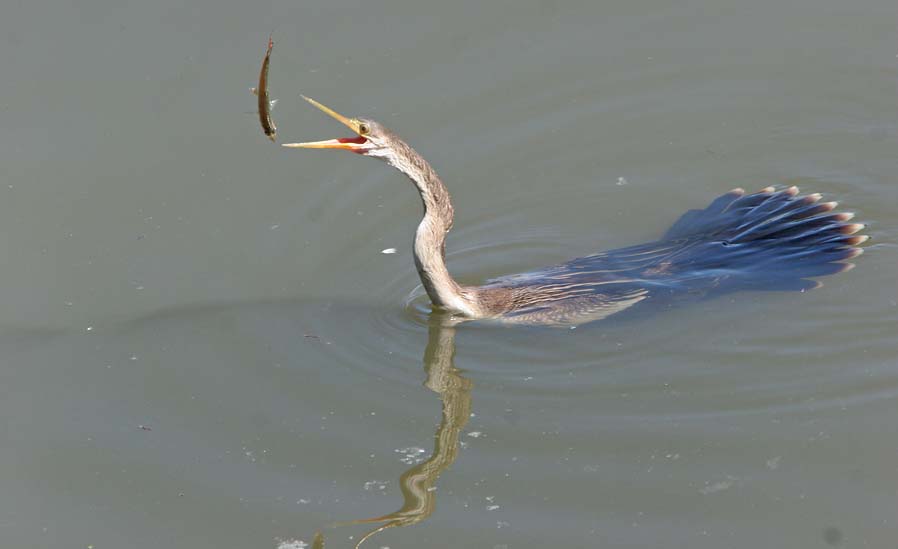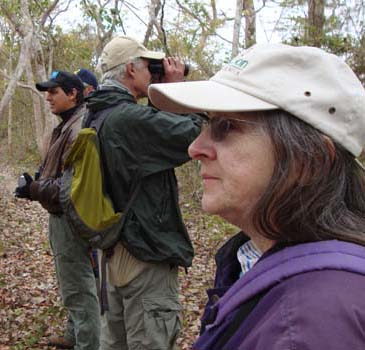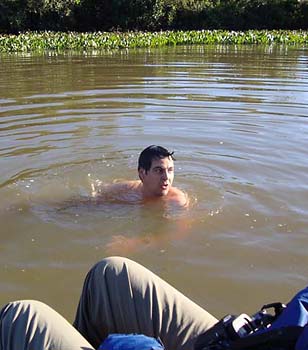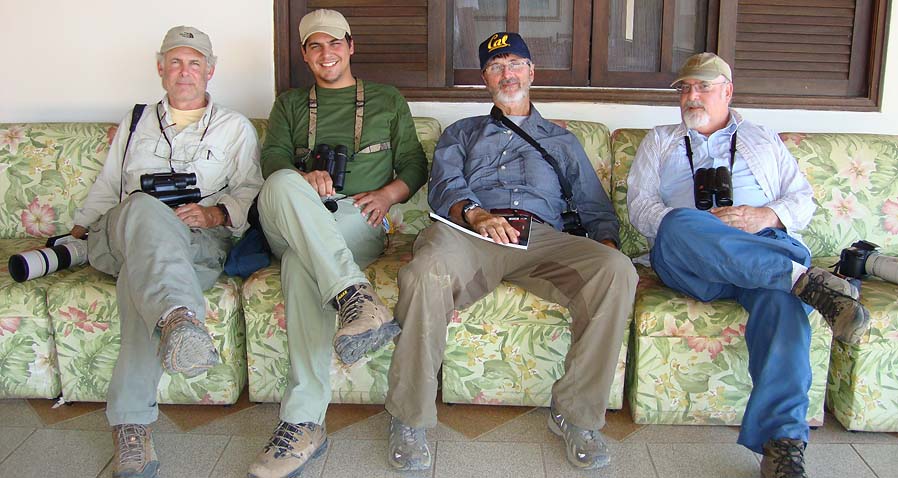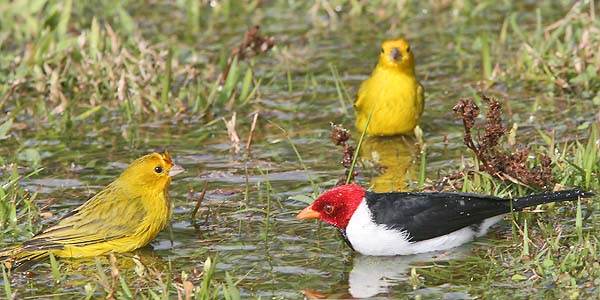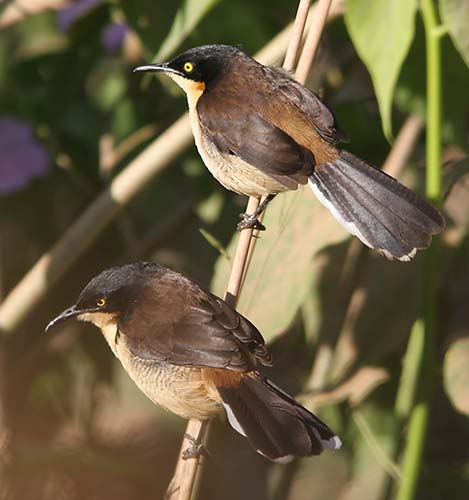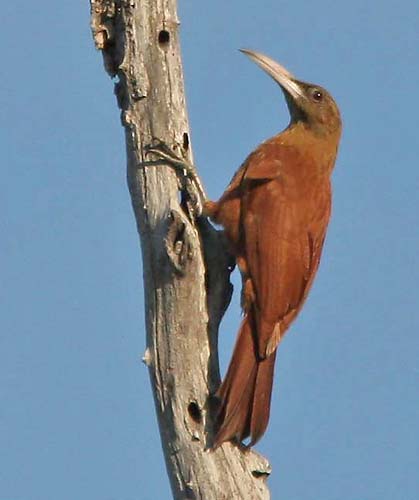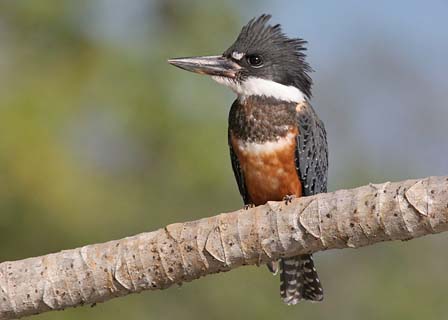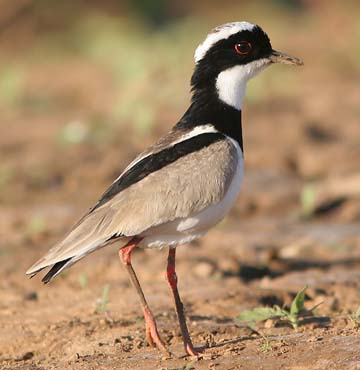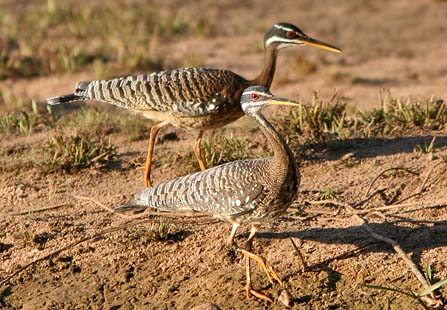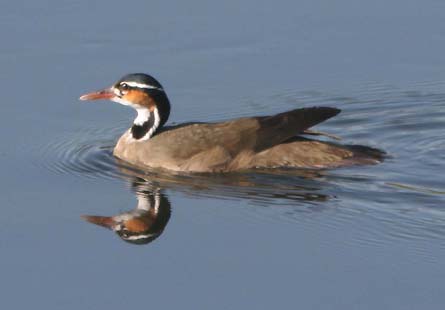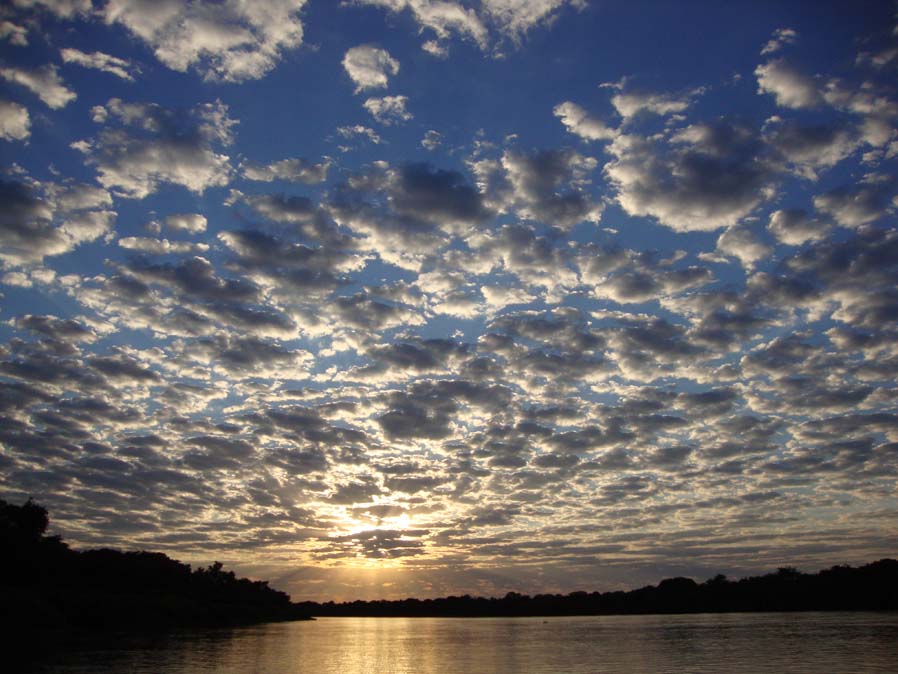TRIP LIST July 2008
PANTANAL
Undulated Tinamou Crypturellus undulates: a few heard daily along rivers
Greater Rhea Rhea americana: up to 6/day along Transpantaneira
Chaco Chachalaca Ortalis canicollis: common
Chestnut-bellied Guan Penelope ochrogaster: a few daily at Rio Claro
Blue-throated Piping Guan Pipile cumanensis: common along Rio Cuiaba & tributaries
Bare-faced Curassow Crax fasciolata: rather common around lodges, where often tame
Horned Screamer Anhima cornuta: a couple on small pond halfway to Emas, far from Pantanal
Southern Screamer Chauna torquata: a few daily
White-faced Whistling Duck Dendrocygna viduata: one pond had 20
Black-bellied Whistling Duck Dendrocygna autumnalis: a few scattered
Muscovy Duck Cairina moschata: a few along Transpantaneira
Brazilian Teal Amazonetta brasiliensis: a pair along Transpantaneira
Neotropic Cormorant Phalacrocorax brasilianus: abundant
Anhinga Anhinga anhinga: common daily
Rufescent Tiger Heron Tigrisoma lineatum: remarkable common
Agami Heron Agamia agami: one imm seen roosting on Rio Claro
Boat-billed Heron Cochlearius cochlearius: a couple at dusk in northern Pantanal
Black-crowned Night Heron Nycticorax nycticorax: fairly common
Striated Heron Butorides striata: common daily
Cattle Egret Bubulcus ibis: common daily
Cocoi Heron Ardea cocoi: common daily along rivers
Great Egret Ardea alba: abundant
Capped Heron Pilherodius pileatus: a few pairs here and there
Whistling Heron Syrigma sibilatrix: a few scattered pairs
Little Blue Heron Egretta caerulea: 1 adult along Transpantaneira
Snowy Egret Egretta thula: abundant
Plumbeous Ibis Theristicus caerulescens: small numbers daily
Buff-necked Ibis Theristicus caudatus: a few daily
Green Ibis Mesembrinibis cayennensis: scattered individuals. scarce
Bare-faced Ibis Phimosus infuscatus: a few pairs
Roseate Spoonbill Platalea ajaja: common but patchy
Wood Stork Mycteria americana: abundant
Jabiru Jabiru mycteria: some daily, well distributed & conspicuous
Turkey Vulture Cathartes aura: a few only
Lesser Yellow-headed Vulture Cathartes burrovianus: common
Black Vulture Coragyps atratus: abundant
Snail Kite Rostrhamus sociabilis: common
Crane Hawk Geranospiza caerulescens: only 2, but one watching reading into a hole in a tree
Great Black Hawk Buteogallus urubitinga: a few daily
Savanna Hawk Buteogallus meridionalis: seen daily in small numbers
Black-collared Hawk Busarellus nigricollis: fairly common daily
Roadside Hawk Buteo magnirostris: common
Southern Caracara Caracara plancus: abundant
Yellow-headed Caracara Milvago chimachima: a few scattered
Laughing Falcon Herpetotheres cachinnans: just a couple along Transpantaneira
Bat Falcon Falco rufigularis: several at dusk, sometimes hunting bats, on two days
Aplomado Falcon Falco femoralis: scarce, only a couple
Red-legged Seriema Cariama cristata: one along northern Transpantaneira
Sunbittern Eurypyga helias: two at Rio Claro, three at Pousada Piuval
Sungrebe Heliornis fulica: one swimming at edge of Rio Claro; a male frequented a small pond in southern Pantanal
Gray-necked Wood Rail Aramides cajanea: common
Purple Gallinule Porphyrio martinicus: a single imm along Transpantaneira
Limpkin Aramus guarauna: small numbers daily on Transpantaneira
Southern Lapwing Vanellus chilensis: common
Pied Plover Vanellus cayanus: a few on sandbars on Rio Cuiaba & tributaries
Wattled Jaçana Jacana jacana: common
Yellow-billed Tern Sternula superciliari: a few daily on Rio Cuiaba & tributaries
Large-billed Tern Phaetusa simplex: a few daily on Rio Cuiaba & tributaries
Black Skimmer Rynchops niger: a few daily on Rio Cuiaba & tributaries
Rock Pigeon Columba livia: non-native introduction — common in towns north of Picone
Picazuro Pigeon Patagioenas picazuro: common
Scaled Dove Scardafella squammata: a few in northern Pantanal
Ruddy Ground Dove Columbina talpacoti: common
Picui Ground Dove Columbina picui: a few in northern Pantanal
Long-tailed Ground Dove Uropelia campestris: three together at one spot, n. Pantanal
White-tipped Dove Leptotila verreauxi: common in woodlands
Hyacinth Macaw Anodorhynchus hyacinthinus: a few pairs most days; nest seen Rio Cuiaba
Yellow-collared Macaw Primolius auricollis: small numbers in southern Pantanal
Blue-crowned Parakeet Aratinga acuticaudata: common in southern Pantanal
Nanday Parakeet Nandayus nenday: a few pairs around Rio Claro
Monk Parakeet Myiopsitta monachus: several local breeding colonies
Yellow-chevroned Parakeet Brotogeris chiriri: a few most days
Scaly-headed Parrot Pionus maximiliani: one pair at Rio Claro
Blue-fronted Amazon Amazona aestiva: widespread and common
Orange-winged Amazon Amazona amazonica: a few pairs scattered
Guira Cuckoo Guira guira: common
Smooth-billed Ani Crotophaga ani: very common
Striped Cuckoo Tapera naevia: one heard in southern Pantanal
Little Cuckoo Coccycua minuta: a few along Rio Cuiaba
Squirrel Cuckoo Piaya cayana: a few seen here and there
Tropical Screech-Owl Megascops choliba: one seen on entrance road to Rio Claro
Great Horned Owl Bubo virginianus: a pair at nest site in southern Pantanal, a few others heard
Ferruginous Pygmy-Owl Glaucidium brasilianum: a couple heard in woodlands
Burrowing Owl Athene cunicularia: a few daily in field at Rio Claro
Great Potoo Nyctibius grandis: two seen at different spots at night
Common Potoo Nyctibius griseus: single seen on two nights, different sites
Band-tailed Nighthawk Nyctiprogne leucopyga: up to 100 at dusk in southern Pantanal
Nacunda Nighthawk Podager nacunda: common in southern Pantanal, some at day roosts at lake edge at Porto Jofre Hotel
Pauraque Nyctidromus albicollis: heard most nights, some seen
Spot-tailed Nightjar Caprimulgus maculicaudus: one seen at night at Pousada Piuval
Scissor-tailed Nightjar Hydropsalis torquata:
male in flight over southern Transpantaneira on one night drive; a
half-dozen (males & females) seen at night at Pousada Piuval
White-tailed Goldenthroat Polytmus guainumbi: one in northern Pantanal
Glittering-throated Emerald Amazilia fimbriata: a few daily along Transpantaneira
Blue-crowned Trogon Trogon curucui: a couple of observations in riverine forests
American Pygmy Kingfisher Chloroceryle aenea: a pair called in with tape in a small woodlot in the southern Pantanal
Green Kingfisher Chloroceryle americana: a few daily
Amazon Kingfisher Chloroceryle amazona: common
Ringed Kingfisher Megaceryle torquata: common
Rufous-tailed Jacamar Galbula ruficauda: a few pairs in riverine woods
Chaco Puffbird Nystalus striatipectus: a male called in at dusk in woods at Pousada Piuval for great looks & photos
Black-fronted Nunbird Monasa nigrifrons: a few most days in riverine woods
Chestnut-eared Aracari Pteroglossus castanotis: patchy; most regular (15/trip) along Rio Cuiaba
Toco Toucan Ramphastos toco: small numbers daily
White-wedged Piculet Picumnus albosquamatus: one in woods at Pousada Piuval
White Woodpecker Melanerpes candidus: scarce in northern Pantanal
Little Woodpecker Veniliornis passerines: a very few but widespread, seen almost daily
Green-barred Woodpecker Colaptes melanochloros: one landed on the “Transpantaneira” arching entrance sign on our way out Campo Flicker Colaptes campestris: widespread but patchy in occurrence
Pale-crested Woodpecker Celeus lugubris: one in wood at Rio Claro, and a pair in south Pantanal
Cream-colored Woodpecker Celeus flavus: a pair called in along Rio Cuiaba
Crimson-crested Woodpecker Campephilus melanoleucos: a few scattered individuals
Pale-legged Hornero Furnarius leucopus: a few along rivers
Rufous Hornero Furnarius rufus: widespread and common
Cinereous-breasted Spinetail Synallaxis hypospodia: at least one seen well in southern Pantanal
White-lored Spinetail Synallaxis albilora:
this local endemic was seen at several in marshy spots along the
Transpantaneira; it was very useful that Marcelo knew the vocalizations
Rusty-backed Spinetail Cranioleuca vulpine: reasonably common in riparian thickets at river edges
Yellow-chinned Spinetail Certhiaxis cinnamomeus: widespread and common in marshy areas
Greater Thornbird Phacellodomus ruber: a few nesting at Porto Jofre Lodge
Great Rufous Woodcreeper Xiphocolaptes major:
this ‘most wanted’ specialty was found in pairs at two sites in
northern Pantanal, and head at another. Marcelo called birds in with
tape for great views
Straight-billed Woodcreeper Dendroplex picus: one at Rio Claro was seen
Narrow-billed Woodcreeper Lepidocolaptes angustirostris: fairly common in riverine forest
Great Antshrike Taraba major: heard daily in northern Pantanal thickets
Barred Antshrike Thamnophilus doliatus: heard daily in southern Pantanal thickets
Plain Antvireo Dysithamnus mentalis: female seen at Rio Claro (others had more)
Large-billed Antwren Herpsilochmus longirostris: a pair in riverine forest at Rio Claro
Rusty-backed Antwren Formicivora rufa: a few seen in northern Pantanal
Mato Grosso Antbird Cercomacra melanaria: a pair inside riverine forest at Rio Claro
Yellow-bellied Elaenia Elaenia flavogaster: a single bird seen along the central Transpantaneira
Southern Beardless Tyrannulet Camptostoma obsoletum: a few daily in patchy woods
Plain Inezia (Tyrannulet) Inezia inornata: one seen (others heard) at Rio Claro
Rusty-fronted Tody-Flycatcher Poecilotriccus latirostris: skittish, but a few seen in roadside thickets along the Transpantaneira Common Tody-Flycatcher Todirostrum cinereum: a few in wooded patches
Fuscous Flycatcher Cnemotriccus fuscatus: an understory bird seen in several woodlands
Vermilion Flycatcher Pyrocephalus rubinus: widespread and a few seen daily in open areas
Yellow-browed Tyrant Satrapa icterophrys: one in a marsh in southern Pantanal
White-rumped Monjita Xolmis velatus: a couple at Rio Claro around lodge
Black-backed Water Tyrant Fluvicola albiventer: a few daily in marshes along the Transpantaneira
White-headed Marsh Tyrant Arundinicola leucocephala: less common than the preceding, but a few here and there
Cattle Tyrant Machetornis rixosa: widespread in open habitats with cattle or capybara
Rusty-margined Flycatcher Myiozetetes cayanensis: widespread
Great Kiskadee Pitangus sulphuratus: widespread and common
Lesser Kiskadee Philohydor lector: common along river edges, usually low near the water
Boat-billed Flycatcher Megarynchus pitangua: a few in wooded habitats
Tropical Kingbird Tyrannus melancholicus: widespread and fairly common
Rufous Casiornis Casiornis rufus: a few around Rio Claro
Short-crested Flycatcher Myiarchus ferox: widespread in small numbers
Brown-crested Flycatcher Myiarchus tyrannulus: one at Pousada Piuval
White-eyed (Dull-cap) Attila Attila bolivianus: one seen well in riverine forest at Rio Claro
Rufous-browed Peppershrike Cyclarhis gujanensis: heard most days along rivers, a few seen
Purplish Jay Cyanocorax cyanomelas: flocks were erratic in riverine forests
White-winged Swallow Tachycineta albiventer: common and widespread
Gray-breasted Martin Progne chalybea: just a couple here and there
Southern Rough-winged Swallow Stelgidopteryx ruficollis: common in southern Pantanal
Black-capped Donacobius Donacobius atricapilla: colonies found daily in marshes or river edge reeds
Thrush-like Wren Campylorhynchus turdinus: common around Rio Claro, a few elsewhere
Moustached Wren Thryothorus genibarbis: three at Rio Claro
Fawn-breasted Wren Thryothorus guarayanus: heard several spots, seen well once
(Southern) House Wren Troglodytes (aedon) musculus: one singing at Rio Claro
Masked Gnatcatcher Polioptila dumicola: a few encountered most days
Chalk-browed Mockingbird Mimus saturninus: one near Picone
Rufous-bellied Thrush Turdus rufiventris: a few at lodges along Transpantaneira
Pale-breasted Thrush Turdus leucomelas: one in wooded patch Transpantaneira
Yellowish Pipit Anthus lutescens: a few seen or heard in open fields
Yellow-billed Cardinal Paroaria capitata: very common and widespread, esp. at lodge feeders
Orange-headed Tanager Thlypopsis sordida: a pair at a small woodland edge in south Pantanal
Silver-beaked Tanager Ramphocelus carbo: common
Sayaca Tanager Thraupis sayaca: a few most days
Chestnut-vented Conebill Conirostrum speciosum: three at Rio Claro
Saffron Finch Sicalis flaveola: common and widespread, often at lodge feeders
Rusty-collared Seedeater Sporophila collaris: a few encountered on most days along Transpantaneira
Double-collared Seedeater Sporophila caerulescens: patchy but could be common
White-bellied Seedeater Sporophila leucoptera: two singles on widely separated days
Tawny-bellied Seedeater Sporophila hypoxantha: a very few in northern Pantanal
Yellow-bellied Seedeater Sporophila nigricollis : one bird with other seedeaters south of Picone
Chestnut-bellied Seed-Finch Oryzoborus angolensis: a couple along central Transpantaneira
Red-crested Finch Coryphospingus cucullatus: small flock south of Picone were all we saw
Saffron-billed Sparrow Arremon flavirostris: one seen after much struggle near dusk inside woods at Pousada Piuval
Grayish Saltator Saltator coerulescens: a few most days, widespread but not common
Black-throated Saltator Saltator atricollis: a pair south of Picone
Chopi Blackbird Gnorimopsar chopi: in flocks in Picone area, but none seen farther south
Scarlet-headed Blackbird Amblyramphus holosericeus: local but one spot had a dozen
Unicolored Blackbird Agelasticus cyanopus: patchy and scattered
Baywing (Cowbird) Agelaioides badius: daily in northern Pantanal, often at feeders there
Screaming Cowbird Molothrus rufoaxillaris: one seen with cows in northern Pantanal
Giant Cowbird Molothrus oryzivorus: a few most days in open country with ranches
Shiny Cowbird Molothrus bonariensis: could be very common on ranches, but patchy
Epaulet Oriole Icterus cayanensis: a couple at Pousada Piuval
Orange-backed Troupial Icterus croconotus: singles daily along Transpantaneira
Yellow-rumped Cacique Cacicus cela: patchy in colonies along Transpantaneira
House Sparrow Passer domesticus: non-native introduction — common in Picone
Birds that were heard/seen by our guide only: Amazonian Motmot Momotus momota, Gray-crested Cacholote Pseudoseisura unirufa, Red-billed Scythebill Campylorhamphus trochilirostris, Band-tailed Antbird Hypocnemoides maculicauda, Forest Elaenia Myiopagis gaimardii, Tawny-crowned Pygmy Tyrant Euscarthmus meloryphus, Yellow-olive Flatbill Tolmomyias sulphurescens, Helmeted Manakin Antilophia galeata, Ashy-headed Greenlet Hylophilus pectoralis, Brown-chested Martin Progne tapera, Buff-breasted Wren Thryothorus leucotis, Flavescent Warbler Basileuterus flaveolus, Palm Tanager Thraupis palmarum, Solitary Cacique Cacicus solitarius, Crested Oropendola Psarocolius decumanus.
For mammals, see my Mammals
two-page set. I am still sorting out our Herps (amphibians &
reptiles) and Odes (dragonflies), although, obviously, the headline
photo at the top is a Paraguayan Caiman Caiman yacare. |
